Abstract
A strain of Aspergillus nidulans carrying a temperature-sensitive mutation in the manA gene produces cell walls depleted of D-mannose and forms hyphal tip balloons at the restrictive temperature (B.P. Valentine and B.W. Bainbridge, J. Gen. Microbiol. 109:155-168, 1978). We have isolated and characterized the manA gene and physically located it between 3.5 and 5.5 kb centromere distal of the riboB locus on chromosome VIII. The manA gene contains four introns and encodes a 50.6-kDa protein which has significant sequence identity to type I phosphomannose isomerase proteins from other eukaryotes. We have constructed by integrative transformation a null mutation in the manA gene which can only be maintained in a heterokaryotic strain with wild-type manA+ nuclei. Thus, a manA null mutation is lethal in A. nidulans. The phenotype of the mutation was analyzed in germinating conidia. Such conidia are able to commence germination but swell abnormally, sometimes producing a misshapen germ tube, before growth ceases. The reason for the lethality is probably the lack of synthesis of mannose-containing cell wall polymers that must be required for normal cell wall development in growing hyphae.
Full text
PDF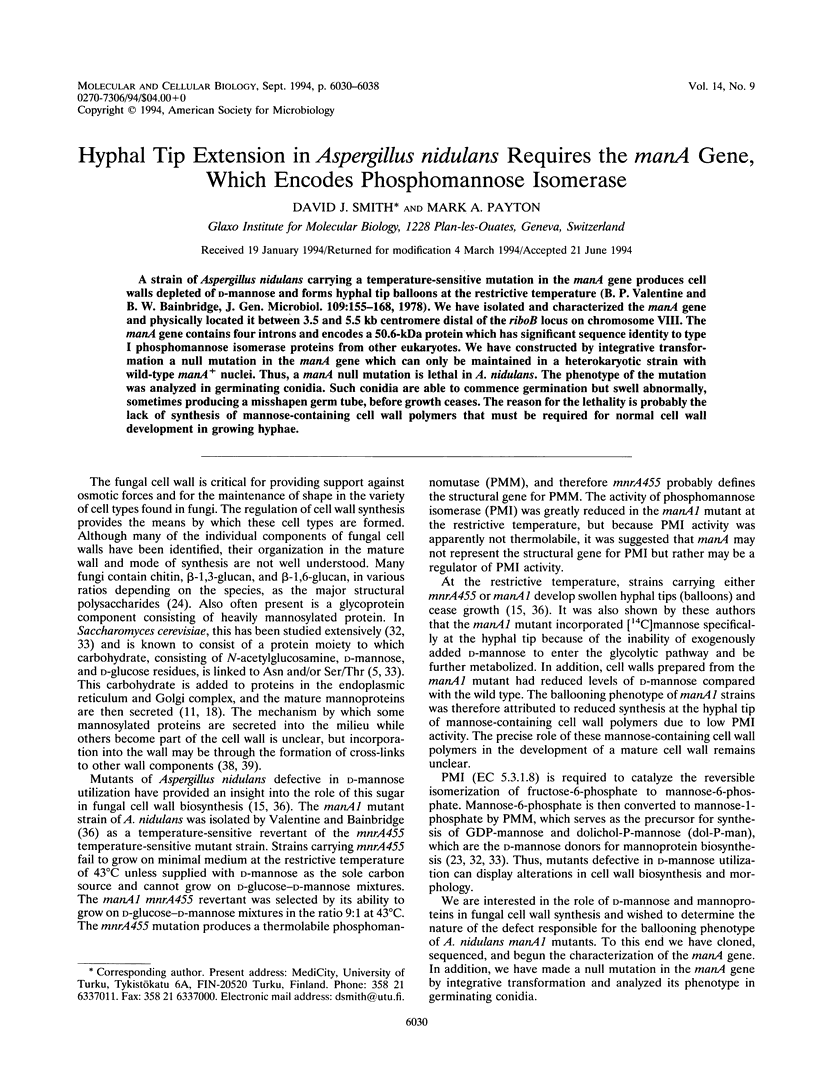
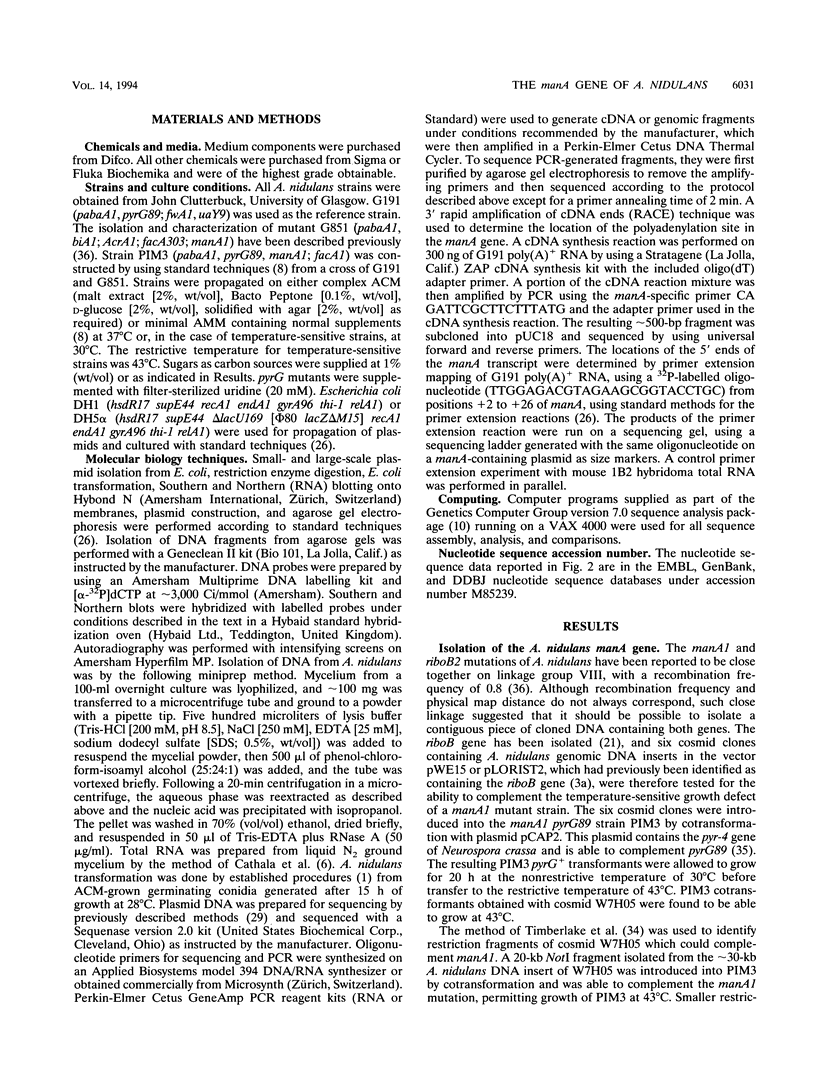
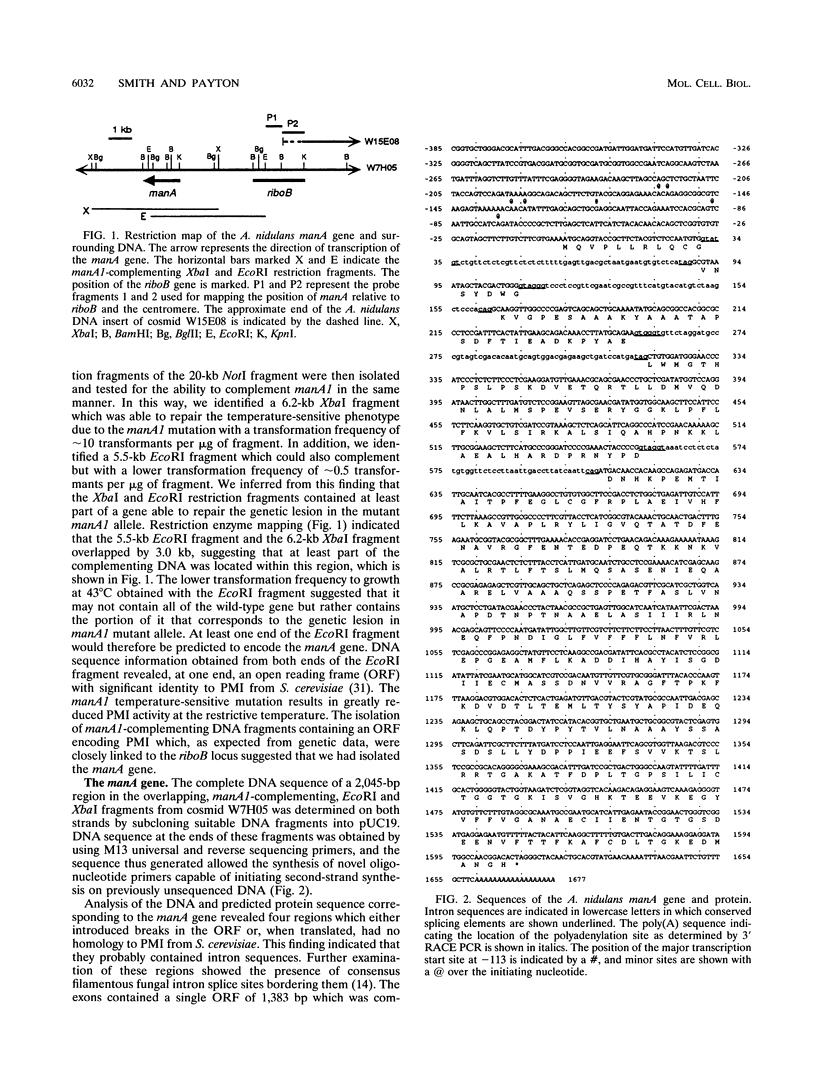
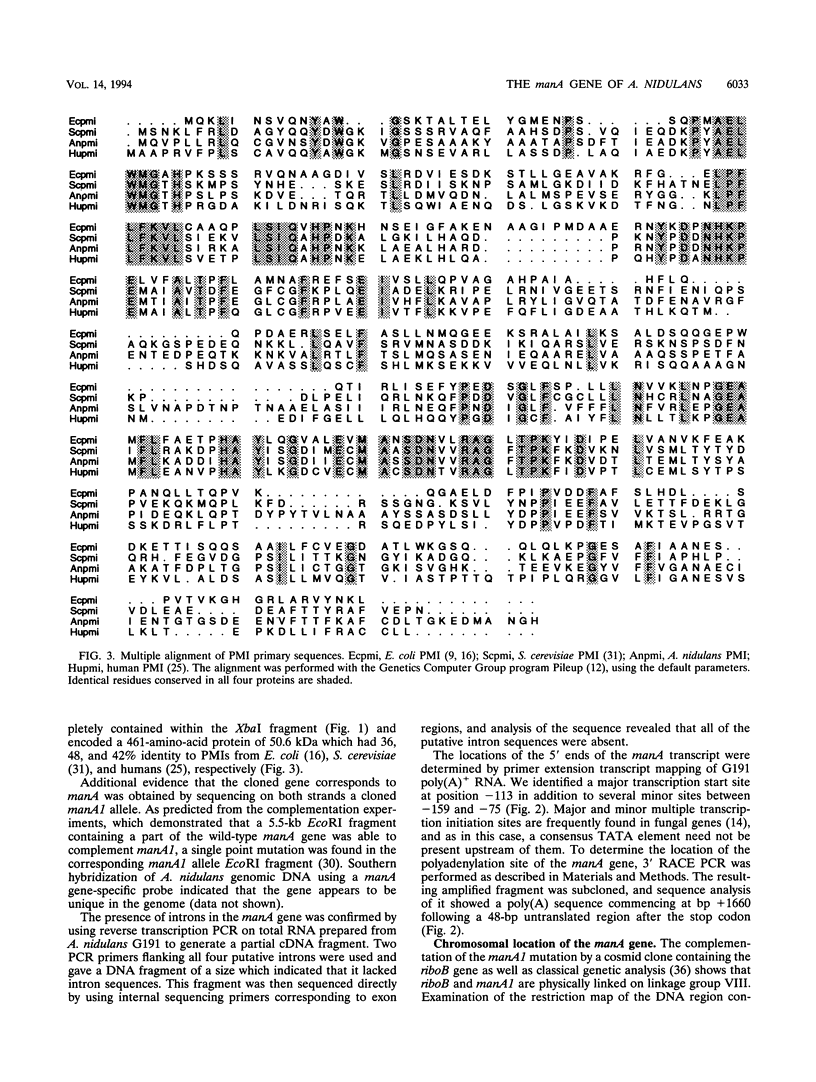
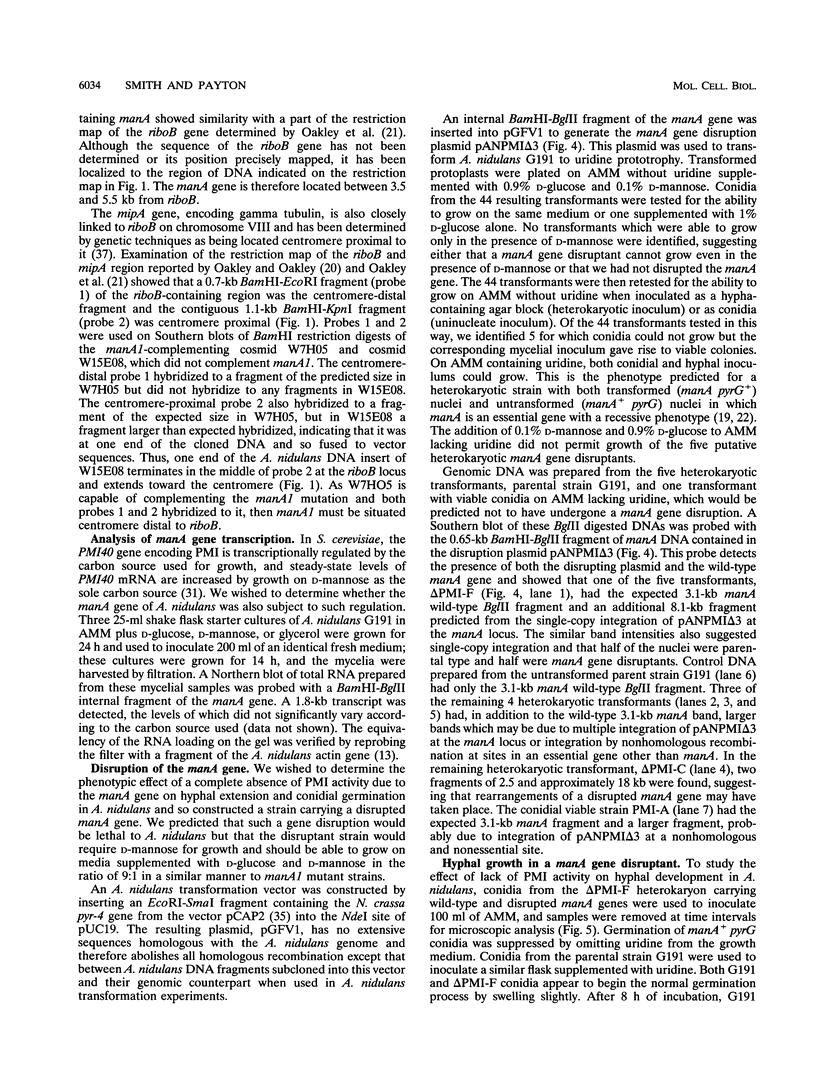

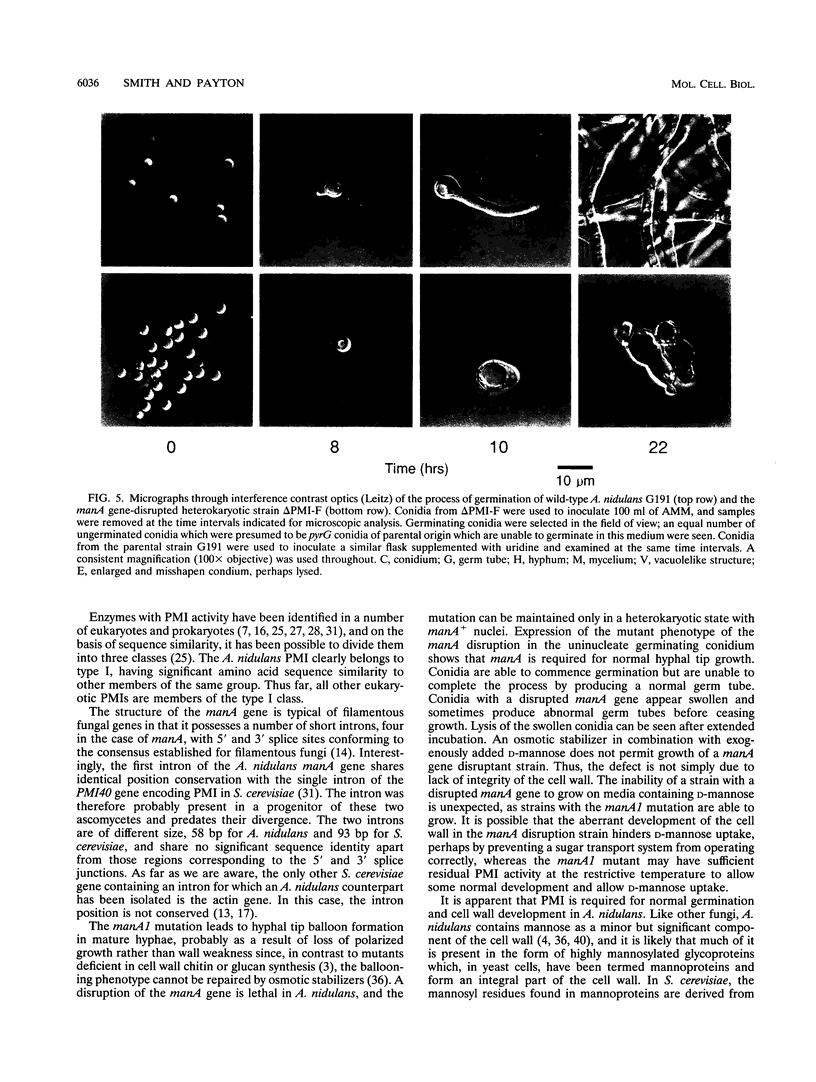
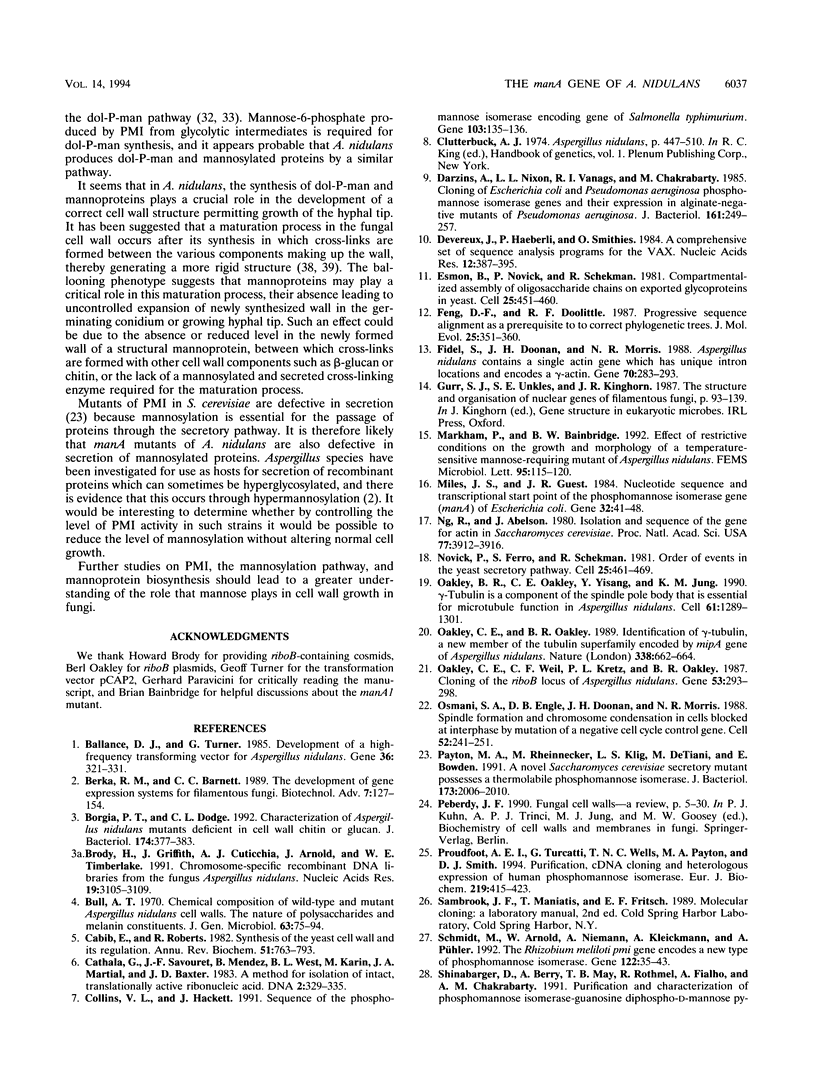
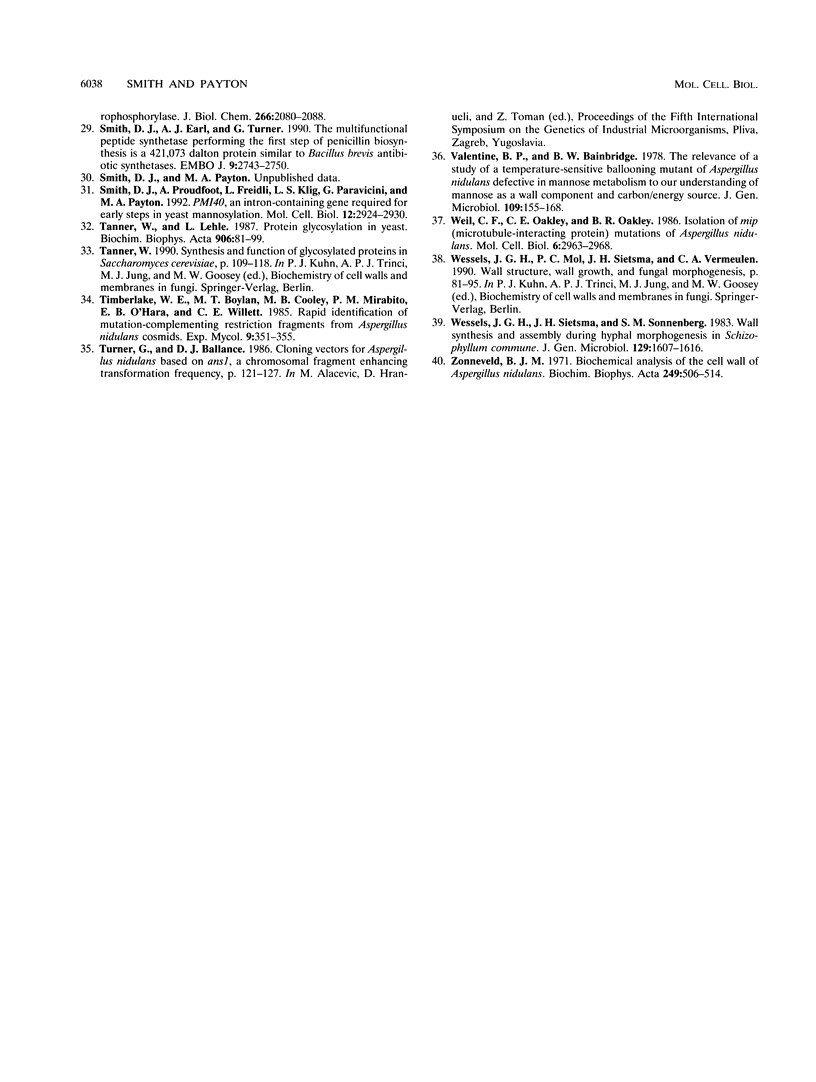
Images in this article
Selected References
These references are in PubMed. This may not be the complete list of references from this article.
- Ballance D. J., Turner G. Development of a high-frequency transforming vector for Aspergillus nidulans. Gene. 1985;36(3):321–331. doi: 10.1016/0378-1119(85)90187-8. [DOI] [PubMed] [Google Scholar]
- Berka R. M., Barnett C. C. The development of gene expression systems for filamentous fungi. Biotechnol Adv. 1989;7(2):127–154. doi: 10.1016/0734-9750(89)90356-x. [DOI] [PubMed] [Google Scholar]
- Borgia P. T., Dodge C. L. Characterization of Aspergillus nidulans mutants deficient in cell wall chitin or glucan. J Bacteriol. 1992 Jan;174(2):377–383. doi: 10.1128/jb.174.2.377-383.1992. [DOI] [PMC free article] [PubMed] [Google Scholar]
- Brody H., Griffith J., Cuticchia A. J., Arnold J., Timberlake W. E. Chromosome-specific recombinant DNA libraries from the fungus Aspergillus nidulans. Nucleic Acids Res. 1991 Jun 11;19(11):3105–3109. doi: 10.1093/nar/19.11.3105. [DOI] [PMC free article] [PubMed] [Google Scholar]
- Bull A. T. Chemical composition of wild-type and mutant Aspergillus nidulans cell walls. The nature of polysaccharide and melanin constituents. J Gen Microbiol. 1970 Sep;63(1):75–94. doi: 10.1099/00221287-63-1-75. [DOI] [PubMed] [Google Scholar]
- Cabib E., Roberts R., Bowers B. Synthesis of the yeast cell wall and its regulation. Annu Rev Biochem. 1982;51:763–793. doi: 10.1146/annurev.bi.51.070182.003555. [DOI] [PubMed] [Google Scholar]
- Cathala G., Savouret J. F., Mendez B., West B. L., Karin M., Martial J. A., Baxter J. D. A method for isolation of intact, translationally active ribonucleic acid. DNA. 1983;2(4):329–335. doi: 10.1089/dna.1983.2.329. [DOI] [PubMed] [Google Scholar]
- Collins L. V., Hackett J. Sequence of the phosphomannose isomerase-encoding gene of Salmonella typhimurium. Gene. 1991 Jul 15;103(1):135–136. doi: 10.1016/0378-1119(91)90406-2. [DOI] [PubMed] [Google Scholar]
- Darzins A., Nixon L. L., Vanags R. I., Chakrabarty A. M. Cloning of Escherichia coli and Pseudomonas aeruginosa phosphomannose isomerase genes and their expression in alginate-negative mutants of Pseudomonas aeruginosa. J Bacteriol. 1985 Jan;161(1):249–257. doi: 10.1128/jb.161.1.249-257.1985. [DOI] [PMC free article] [PubMed] [Google Scholar]
- Devereux J., Haeberli P., Smithies O. A comprehensive set of sequence analysis programs for the VAX. Nucleic Acids Res. 1984 Jan 11;12(1 Pt 1):387–395. doi: 10.1093/nar/12.1part1.387. [DOI] [PMC free article] [PubMed] [Google Scholar]
- Esmon B., Novick P., Schekman R. Compartmentalized assembly of oligosaccharides on exported glycoproteins in yeast. Cell. 1981 Aug;25(2):451–460. doi: 10.1016/0092-8674(81)90063-5. [DOI] [PubMed] [Google Scholar]
- Feng D. F., Doolittle R. F. Progressive sequence alignment as a prerequisite to correct phylogenetic trees. J Mol Evol. 1987;25(4):351–360. doi: 10.1007/BF02603120. [DOI] [PubMed] [Google Scholar]
- Fidel S., Doonan J. H., Morris N. R. Aspergillus nidulans contains a single actin gene which has unique intron locations and encodes a gamma-actin. Gene. 1988 Oct 30;70(2):283–293. doi: 10.1016/0378-1119(88)90200-4. [DOI] [PubMed] [Google Scholar]
- Markham P., Bainbridge B. W. Effect of restrictive conditions on the growth and morphology of a temperature-sensitive mannose-requiring mutant of Aspergillus nidulans. FEMS Microbiol Lett. 1992 Aug 1;74(1):115–120. doi: 10.1016/0378-1097(92)90746-b. [DOI] [PubMed] [Google Scholar]
- Miles J. S., Guest J. R. Nucleotide sequence and transcriptional start point of the phosphomannose isomerase gene (manA) of Escherichia coli. Gene. 1984 Dec;32(1-2):41–48. doi: 10.1016/0378-1119(84)90030-1. [DOI] [PubMed] [Google Scholar]
- Ng R., Abelson J. Isolation and sequence of the gene for actin in Saccharomyces cerevisiae. Proc Natl Acad Sci U S A. 1980 Jul;77(7):3912–3916. doi: 10.1073/pnas.77.7.3912. [DOI] [PMC free article] [PubMed] [Google Scholar]
- Novick P., Ferro S., Schekman R. Order of events in the yeast secretory pathway. Cell. 1981 Aug;25(2):461–469. doi: 10.1016/0092-8674(81)90064-7. [DOI] [PubMed] [Google Scholar]
- Oakley B. R., Oakley C. E., Yoon Y., Jung M. K. Gamma-tubulin is a component of the spindle pole body that is essential for microtubule function in Aspergillus nidulans. Cell. 1990 Jun 29;61(7):1289–1301. doi: 10.1016/0092-8674(90)90693-9. [DOI] [PubMed] [Google Scholar]
- Oakley C. E., Oakley B. R. Identification of gamma-tubulin, a new member of the tubulin superfamily encoded by mipA gene of Aspergillus nidulans. Nature. 1989 Apr 20;338(6217):662–664. doi: 10.1038/338662a0. [DOI] [PubMed] [Google Scholar]
- Oakley C. E., Weil C. F., Kretz P. L., Oakley B. R. Cloning of the riboB locus of Aspergillus nidulans. Gene. 1987;53(2-3):293–298. doi: 10.1016/0378-1119(87)90019-9. [DOI] [PubMed] [Google Scholar]
- Osmani S. A., Engle D. B., Doonan J. H., Morris N. R. Spindle formation and chromatin condensation in cells blocked at interphase by mutation of a negative cell cycle control gene. Cell. 1988 Jan 29;52(2):241–251. doi: 10.1016/0092-8674(88)90513-2. [DOI] [PubMed] [Google Scholar]
- Payton M. A., Rheinnecker M., Klig L. S., DeTiani M., Bowden E. A novel Saccharomyces cerevisiae secretory mutant possesses a thermolabile phosphomannose isomerase. J Bacteriol. 1991 Mar;173(6):2006–2010. doi: 10.1128/jb.173.6.2006-2010.1991. [DOI] [PMC free article] [PubMed] [Google Scholar]
- Proudfoot A. E., Turcatti G., Wells T. N., Payton M. A., Smith D. J. Purification, cDNA cloning and heterologous expression of human phosphomannose isomerase. Eur J Biochem. 1994 Jan 15;219(1-2):415–423. doi: 10.1111/j.1432-1033.1994.tb19954.x. [DOI] [PubMed] [Google Scholar]
- Schmidt M., Arnold W., Niemann A., Kleickmann A., Pühler A. The Rhizobium meliloti pmi gene encodes a new type of phosphomannose isomerase. Gene. 1992 Dec 1;122(1):35–43. doi: 10.1016/0378-1119(92)90029-o. [DOI] [PubMed] [Google Scholar]
- Shinabarger D., Berry A., May T. B., Rothmel R., Fialho A., Chakrabarty A. M. Purification and characterization of phosphomannose isomerase-guanosine diphospho-D-mannose pyrophosphorylase. A bifunctional enzyme in the alginate biosynthetic pathway of Pseudomonas aeruginosa. J Biol Chem. 1991 Feb 5;266(4):2080–2088. [PubMed] [Google Scholar]
- Smith D. J., Earl A. J., Turner G. The multifunctional peptide synthetase performing the first step of penicillin biosynthesis in Penicillium chrysogenum is a 421,073 dalton protein similar to Bacillus brevis peptide antibiotic synthetases. EMBO J. 1990 Sep;9(9):2743–2750. doi: 10.1002/j.1460-2075.1990.tb07461.x. [DOI] [PMC free article] [PubMed] [Google Scholar]
- Smith D. J., Proudfoot A., Friedli L., Klig L. S., Paravicini G., Payton M. A. PMI40, an intron-containing gene required for early steps in yeast mannosylation. Mol Cell Biol. 1992 Jul;12(7):2924–2930. doi: 10.1128/mcb.12.7.2924. [DOI] [PMC free article] [PubMed] [Google Scholar]
- Tanner W., Lehle L. Protein glycosylation in yeast. Biochim Biophys Acta. 1987 Apr 27;906(1):81–99. doi: 10.1016/0304-4157(87)90006-2. [DOI] [PubMed] [Google Scholar]
- Weil C. F., Oakley C. E., Oakley B. R. Isolation of mip (microtubule-interacting protein) mutations of Aspergillus nidulans. Mol Cell Biol. 1986 Aug;6(8):2963–2968. doi: 10.1128/mcb.6.8.2963. [DOI] [PMC free article] [PubMed] [Google Scholar]
- Zonneveld B. J. Biochemical analysis of the cell wall of Aspergillus nidulans. Biochim Biophys Acta. 1971 Dec 3;249(2):506–514. doi: 10.1016/0005-2736(71)90126-x. [DOI] [PubMed] [Google Scholar]




